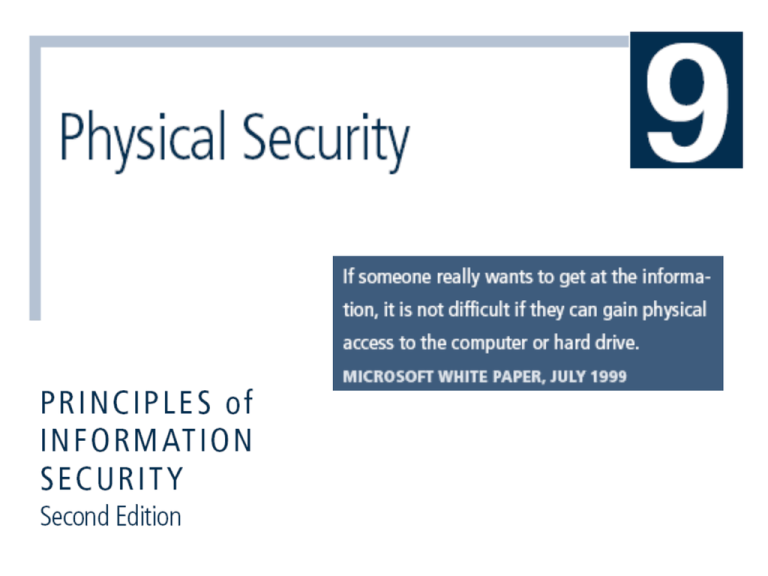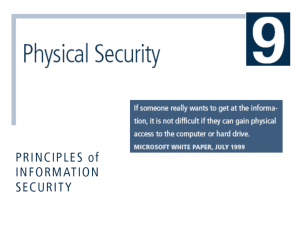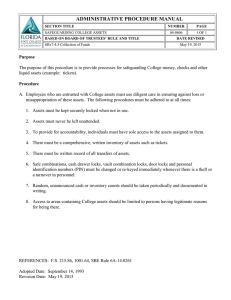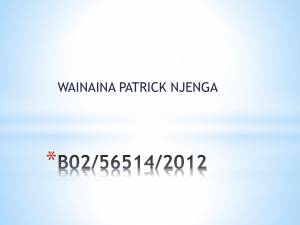Document 15632755
advertisement

Learning Objectives Upon completion of this material, you should be able to: Understand the conceptual need for physical security Identify threats to information security that are unique to physical security Describe the key physical security considerations for selecting a facility site Identify physical security monitoring components Recognize the essential elements of physical access control within the scope of facilities management Understand the importance of fire safety programs to all physical security programs Principles of Information Security, 2nd Edition 2 Learning Objectives (continued) Describe the components of fire detection and response Understand the impact of service interruptions of supporting utilities Understand the technical details of uninterruptible power supplies and how they are used to increase availability of information assets Discuss critical physical environment considerations for computing facilities Discuss the countermeasures used against the physical theft of computing devices Principles of Information Security, 2nd Edition 3 Introduction Physical security addresses design, implementation, and maintenance of countermeasures that protect physical resources of an organization. Most controls can be circumvented if attacker gains physical access Physical security is as important as logical security Principles of Information Security, 2nd Edition 4 Introduction (continued) Seven major sources of physical loss Extreme temperature Gases Liquids Living organisms Projectiles Movement Energy anomalies Principles of Information Security, 2nd Edition 5 Introduction (continued) Community roles General management: responsible for facility security IT management and professionals: responsible for environmental and access security Information security management and professionals: perform risk assessments and implementation reviews Principles of Information Security, 2nd Edition 6 Physical Access Controls Secure facility: physical location engineered with controls designed to minimize risk of attacks from physical threats Secure facility can take advantage of natural terrain, traffic flow, and degree of urban development; can complement these with protection mechanisms (fences, gates, walls, guards, alarms) Principles of Information Security, 2nd Edition 7 Controls for Protecting the Secure Facility Walls, fencing, and gates Guards Dogs ID Cards and badges Locks and keys Principles of Information Security, 2nd Edition 8 Controls for Protecting the Secure Facility (continued) Mantraps Electronic monitoring Alarms and alarm systems Computer rooms and wiring closets Interior walls and doors Principles of Information Security, 2nd Edition 9 ID Cards and Badges Ties physical security with information access control ID card is typically concealed Name badge is visible Serve as simple form of biometrics (facial recognition) Should not be only means of control as cards can be easily duplicated, stolen, and modified Tailgating occurs when unauthorized individual follows authorized user through the control Principles of Information Security, 2nd Edition 10 Locks and Keys Two types of locks: mechanical and electromechanical Locks can also be divided into four categories: manual, programmable, electronic, biometric Locks fail and alternative procedures for controlling access must be put in place Locks fail in one of two ways Fail-safe lock Fail-secure lock Principles of Information Security, 2nd Edition 11 Figure 9-1 Principles of Information Security, 2nd Edition 12 Mantraps Small enclosure that has entry point and different exit point Individual enters mantrap, requests access, and if verified, is allowed to exit mantrap into facility Individual denied entry is not allowed to exit until security official overrides automatic locks of the enclosure Principles of Information Security, 2nd Edition 13 Figure 9-2 Mantraps Principles of Information Security, 2nd Edition 14 Electronic Monitoring Records events where other types of physical controls are impractical or incomplete May use cameras with video recorders; includes closedcircuit television (CCT) systems Drawbacks Reactive; do not prevent access or prohibited activity Recordings often not monitored in real time; must be reviewed to have any value Principles of Information Security, 2nd Edition 15 Alarms and Alarm Systems Alarm systems notify when an event occurs Detect fire, intrusion, environmental disturbance, or an interruption in services Rely on sensors that detect event; e.g., motion detectors, smoke detectors, thermal detectors, glass breakage detectors, weight sensors, contact sensors, vibration sensors Principles of Information Security, 2nd Edition 16 Computer Rooms and Wiring Closets Require special attention to ensure confidentiality, integrity, and availability of information Logical controls easily defeated if attacker gains physical access to computing equipment Custodial staff often the least scrutinized persons who have access to offices; are given greatest degree of unsupervised access Principles of Information Security, 2nd Edition 17 Interior Walls and Doors Information asset security sometimes compromised by construction of facility walls and doors Facility walls typically either standard interior or firewall High-security areas must have firewall-grade walls to provide physical security from potential intruders and improve resistance to fires Doors allowing access to high security rooms should be evaluated Recommended that push or crash bars be installed on computer rooms and closets Principles of Information Security, 2nd Edition 18 Fire Security and Safety Most serious threat to safety of people who work in an organization is possibility of fire Fires account for more property damage, personal injury, and death than any other threat Imperative that physical security plans examine and implement strong measures to detect and respond to fires Principles of Information Security, 2nd Edition 19 Fire Detection and Response Fire suppression systems: devices installed and maintained to detect and respond to a fire Deny an environment of heat, fuel, or oxygen Water and water mist systems Carbon dioxide systems Soda acid systems Gas-based systems Principles of Information Security, 2nd Edition 20 Fire Detection Fire detection systems fall into two general categories: manual and automatic Part of a complete fire safety program includes individuals that monitor chaos of fire evacuation to prevent an attacker accessing offices There are three basic types of fire detection systems: thermal detection, smoke detection, flame detection Principles of Information Security, 2nd Edition 21 Fire Suppression Systems consist of portable, manual, or automatic apparatus Portable extinguishers are rated by the type of fire: Class A, Class B, Class C, Class D Installed systems apply suppressive agents; usually either sprinkler or gaseous systems Principles of Information Security, 2nd Edition 22 Figure 9-3 Water Sprinkler System Principles of Information Security, 2nd Edition 23 Gaseous Emission Systems Until recently, two types of systems: carbon dioxide and Halon Carbon dioxide robs a fire of oxygen supply Halon is clean but has been classified as ozone-depleting substance; new installations are prohibited Alternative clean agents include FM-200, Inergen, carbon dioxide, FE-13 (trifluromethane) Principles of Information Security, 2nd Edition 24 Figure 9-4 Fire Suppression System Principles of Information Security, 2nd Edition 25 Failure Of Supporting Utilities and Structural Collapse Supporting utilities (heating, ventilation and air conditioning; power; water; and others) have significant impact on continued safe operation of a facility Each utility must be properly managed to prevent potential damage to information and information systems Principles of Information Security, 2nd Edition 26 Heating, Ventilation, and Air Conditioning Areas within heating, ventilation, and air conditioning (HVAC) system that can cause damage to information systems include: Temperature Filtration Humidity Static electricity Principles of Information Security, 2nd Edition 27 Ventilation Shafts While ductwork is small in residential buildings, in large commercial buildings it can be large enough for individual to climb though If vents are large, security can install wire mesh grids at various points to compartmentalize the runs Principles of Information Security, 2nd Edition 28 Power Management and Conditioning Electrical quantity (voltage level; amperage rating) is a concern, as is quality of power (cleanliness; proper installation) Noise that interferes with the normal 60 Hertz cycle can result in inaccurate time clocks or unreliable internal clocks inside CPU Grounding ensures that returning flow of current is properly discharged to ground Overloading a circuit causes problems with circuit tripping and can overload electrical cable, increasing risk of fire Principles of Information Security, 2nd Edition 29 Uninterruptible Power Supply (UPS) In case of power outage, UPS is backup power source for major computer systems Four basic UPS configurations Standby Ferroresonant standby Line-interactive True online (double conversion online) Principles of Information Security, 2nd Edition 30 Emergency Shutoff Important aspect of power management is the need to be able to stop power immediately should current represent a risk to human or machine safety Most computer rooms and wiring closets equipped with an emergency power shutoff Principles of Information Security, 2nd Edition 31 Water Problems Lack of water poses problem to systems, including functionality of fire suppression systems and ability of water chillers to provide air-conditioning Surplus of water, or water pressure, poses a real threat (flooding; leaks) Very important to integrate water detection systems into alarm systems that regulate overall facilities operations Principles of Information Security, 2nd Edition 32 Structural Collapse Unavoidable forces can cause failures of structures that house organization Structures designed and constructed with specific load limits; overloading these limits results in structural failure and potential injury or loss of life Periodic inspections by qualified civil engineers assists in identifying potentially dangerous structural conditions Principles of Information Security, 2nd Edition 33 Maintenance of Facility Systems Physical security must be constantly documented, evaluated, and tested Documentation of facility’s configuration, operation, and function should be integrated into disaster recovery plans and operating procedures Testing helps improve the facility’s physical security and identify weak points Principles of Information Security, 2nd Edition 34 Interception of Data Three methods of data interception Direct observation Interception of data transmission Electromagnetic interception U.S. government developed TEMPEST program to reduce risk of electromagnetic radiation (EMR) monitoring Principles of Information Security, 2nd Edition 35 Mobile and Portable Systems With the increased threat to information security for laptops, handhelds, and PDAs, mobile computing requires more security than average in-house system Many mobile computing systems have corporate information stored within them; some are configured to facilitate user’s access into organization’s secure computing facilities Principles of Information Security, 2nd Edition 36 Mobile and Portable Systems (continued) Controls support security and retrieval of lost or stolen laptops CompuTrace software, stored on laptop; reports to a central monitoring center Burglar alarms made up of a PC card that contains a motion detector Principles of Information Security, 2nd Edition 37 Figure 9-6 Laptop Theft Deterrence Principles of Information Security, 2nd Edition 38 Remote Computing Security Remote site computing: away from organizational facility Telecommuting: computing using telecommunications including Internet, dial-up, or leased point-to-point links Employees may need to access networks on business trips; telecommuters need access from home systems or satellite offices To provide secure extension of organization’s internal networks, all external connections and systems must be secured Principles of Information Security, 2nd Edition 39 Special Considerations for Physical Security Threats Develop physical security in-house or outsource? Many qualified and professional agencies Benefit of outsourcing includes gaining experience and knowledge of agencies Downside includes high expense, loss of control over individual components, and level of trust that must be placed in another company Social engineering: use of people skills to obtain information from employees that should not be released Principles of Information Security, 2nd Edition 40 Inventory Management Computing equipment should be inventoried and inspected on a regular basis Classified information should also be inventoried and managed Physical security of computing equipment, data storage media and classified documents varies for each organization Principles of Information Security, 2nd Edition 41 Summary Threats to information security that are unique to physical security Key physical security considerations in a facility site Physical security monitoring components Essential elements of access control Fire safety, fire detection, and response Importance of supporting utilities, especially use of uninterruptible power supplies Countermeasures to physical theft of computing devices Principles of Information Security, 2nd Edition 42




